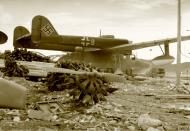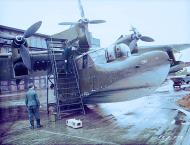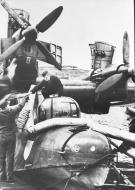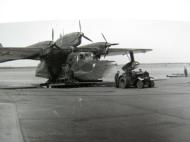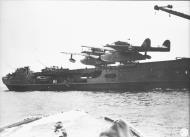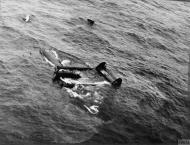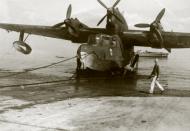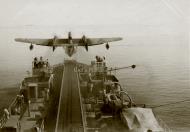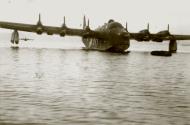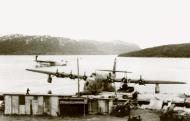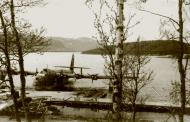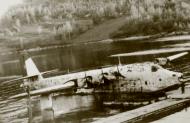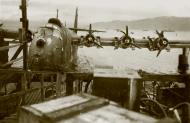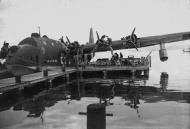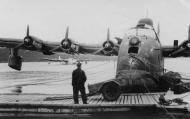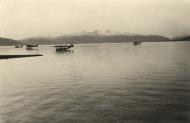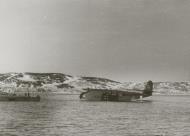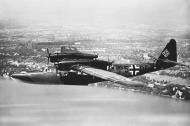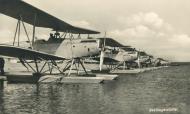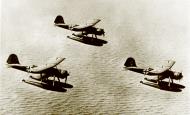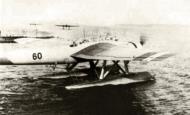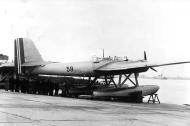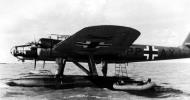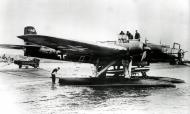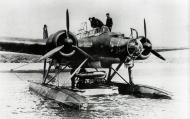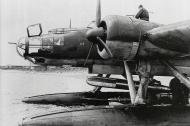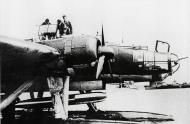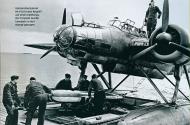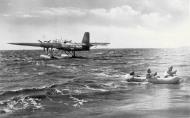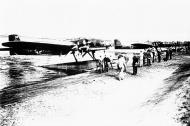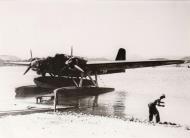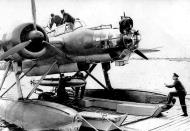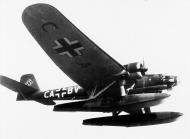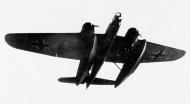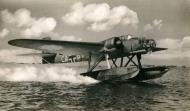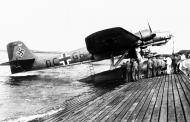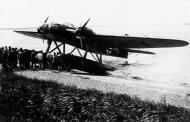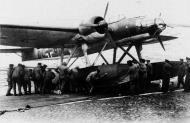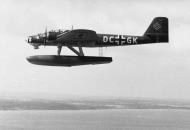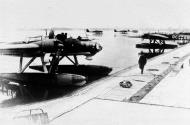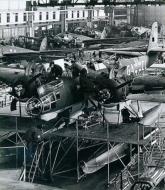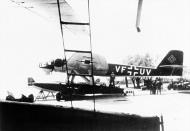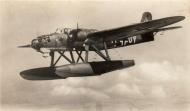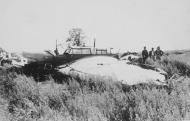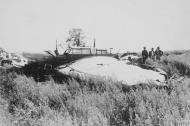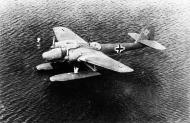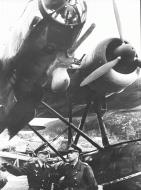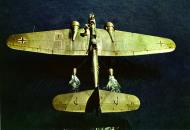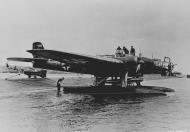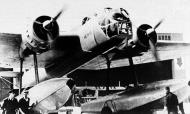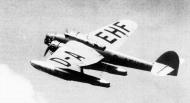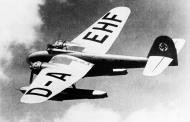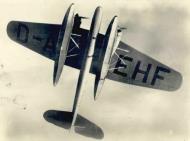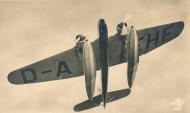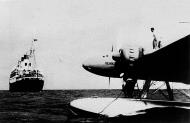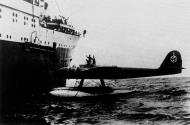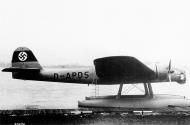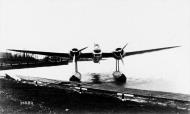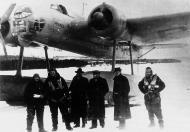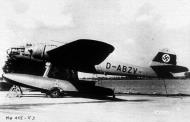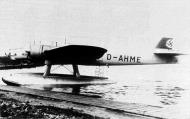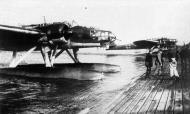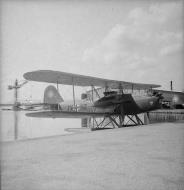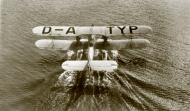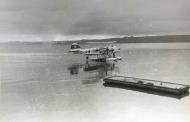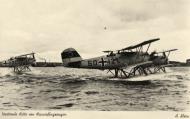Mixed photo's of Heinkel He 115's
Heinkel He 115V1 prototype D-AEHF Monte Pascoal near Porto Seguro in the state of Bahia Brazil 1938 01
Heinkel He 115V1 prototype D-AEHF Monte Pascoal near Porto Seguro in the state of Bahia Brazil 1938 02
Heinkel He 115 mixed photograph's
Blohm and Voss BV 138B seaplane captured at Kiel May 1945
Photo source - IWM A 29084: A captured and damaged German Blohm and Voss BV.138b seaplane, being inspected by Lieutenant-Commander William Dobson RNVR, attached to the Advanced Naval Party at Kiel, in front of a hangar nearby the Kiel canal locks. May 1945 (Note the uniformed German 'observer') Colour By Richard James Molloy
Heinkel He 115A2 Norwegian AF Kampgruppe Manshaus WNr 3042 F58 moving to Shetland 13th Oct 1939
Photo On the picture you see F58, wich was used in the fjords in western Norway by Kampgruppe Manshaus, fighting the invasion of Bergen, and sinking a few german(incl. ex-norwegian) vessels operating in the area. It was later flown to Tromsø in northern Norway and then at last to Shetland, where this picture is taken. It was one of two, out of three(or four) HE 115s flown to the UK, wich was lost due to lack of training by RAF pilots trying to operate it.
Another plane, F52, was later in the war used to ship agents in and out of hostile territory in Africa, with a base on Malta. This plane was lost in an italian bombing raid on the island. The same pilot, Lt Offerdahl, went back to Scotland, meaning to operate a similiar kind of route between Scotland and Norway but this prooved to dangerous as RAF and other aa-forces, due to the secrecy of the route, and with a naturally high presence always detected the Heinkel when out flying. Therefore the route was shut down and the plane was put away in a warehouse until later in the war when it was scrapped. This was the end of the norwegian Heinkels. One evacuated from Norway to Finland was lost over Soviet in 1943.Photo source - https://forum.axishistory.com/viewtopic.php?t=160660
Heinkel He 115 V-1 protype Germany 1937
Heinkel He 115 V-2 protype D-APDS Stkz TI+HF WNr 1554 Travemünde Lübeck Germany 1939
Heinkel He 115 V-3 protype D-ABZV Stkz TI+HB WNr 1555 Travemünde Lübeck Germany 1939
Heinkel He 115 V-3 protype D-AHME Stkz TI+HB WNr 1555 Travemünde Lübeck Germany 1939
Heinkel He 115 C-1 1./Kü.Fl.Gr 106 (M2+AH) Norway 1941
Heinkel He 115 C-1 1./Kü.Fl.Gr 106 (M2+GH) Baltic Coast 1940
Heinkel He 115 C-1 1./Kü.Fl.Gr 106 (M2+HH) Einswarden Germany 3rd Aug 1940
Heinkel He 115 C-1 1./Kü.Fl.Gr 106 (M2+MH) being refuelled Norway 1940
Heinkel He 115 C-1 3./Kü.Fl.Gr 106 (M2+IL) running its engines Baltic Coast
Heinkel He 115 C-1 3./Kü.Fl.Gr 106 (M2+BL) Baltic Coast
Heinkel He 115 B-2 1./Kü.Fl.Gr 406 (K6+CH) WNr 20382 being shot down by a Mosquito from 333Sqn near Bremanger Norway 6th Feb 1944. Ofw Herman Borgards and crew were all in the crash.
Heinkel He 115 C-1 1./Kü.Fl.Gr 406 (K6+GH) Baltic Coast 1940
Heinkel He 115 C-1 1./Kü.Fl.Gr 406 (K6+IH) flown by Oblt Burmeister picking up Hptm Herbert Vater 2nd July 1942
Heinkel He 115 C-1 1./Kü.Fl.Gr 406 (K6+IH) shows their arrival at Sorreisa Norway 2nd July 1942
Oblt Burmeister toasts Hptm Herbert Vater safe return 2nd July 1942
Heinkel He 115 C-1 1./Kü.Fl.Gr 406 (K6+KH) WNr 2503 Norway 1940
Heinkel He 115 B-1 1./Kü.Fl.Gr 406 (K6+TH) undergoing repairs Baltic Coast
Heinkel He 115 C-1 1./Kü.Fl.Gr 506 (S4+??) moored on a slipway Baltic Coast
Heinkel He 115 C-1 1./Kü.Fl.Gr 506 (S4+BH) Baltic Coast
Heinkel He 115 C-1 1./Kü.Fl.Gr 506 (S4+DH) carring a spare float Baltic Coast 1939-40
Heinkel He 115 C-1 1./Kü.Fl.Gr 506 (S4+DL) Baltic Coast
Heinkel He 115 B-1 1./Kü.Fl.Gr 706 (6I+GH) Baltic Coast 1940-41
Heinkel He 115 C-1 2./Kü.Fl.Gr 506 (S4+AK) North Sea
Heinkel He 115 C-1 2./Kü.Fl.Gr 506 (S4+KK) Vardo Norway Sep 1940
Heinkel He 115 1./Kü.Fl.Gr 706 with Heinkel He 59s Aalborg Denmark 1940
Heinkel He 115 C-1 1./Kü.Fl.Gr 906 being refuelled Baltic Coast
Heinkel He 115 C-1 1./Kü.Fl.Gr 906 (8L+CH) at its mooring Finland 1942
Heinkel He 115 C-1 1./Kü.Fl.Gr 906 (8L+EH) flying low over the Norwegian Coast
Heinkel He 115 C-1 1./Kü.Fl.Gr 906 (8L+IH) Finland 1942
Heinkel He 115 C-1 3./Kü.Fl.Gr 906 (8L+KL) France 1940
Heinkel He 115 B-1 Stammkennzeichen Stkz CA+BV Germany 01-02
Heinkel He 115 B-1 Stammkennzeichen Stkz CA+BW Germany 01
Heinkel He 115 C-1 1./Kü.Fl.Gr 906 Stammkennzeichen Stkz VF+UY WNr 3252 Germany 1940
Heinkel He 115 B-1 Stammkennzeichen Stkz TW+H? white 146 Travemünde Lübeck Germany 1941 01
Heinkel He 115 B-1 Stammkennzeichen Stkz TW+H? white 146 probably at Grossenbrode Torpedo School 1941 01-04
Heinkel He 115 B-1 Stammkennzeichen Stkz PP+AX at its moring Baltic CoastMain photographic source: Sea Eagles - Anti-Shipping Units 1939-41 (Vol 1 and 2)
Heinkel He 115
The Heinkel He 115 was a World War II Luftwaffe seaplane with three seats. It was used as a torpedo bomber and performed general seaplane duties, such as reconnaissance and minelaying. The plane was powered by two 960 PS (947 hp, 720 kW) BMW 132K nine-cylinder air-cooled radial engines. Some later models could seat four, had different engines, or used different weapon setups.
The Heinkel He 115 in a nutshell
National origin:- Germany Role:- Torpedo bomber seaplane Manufacturer:- Bayerische Flugzeugwerke Designer:- Heinkel First flight:- August 1937 Introduction:- 1939 Retired: 1945 Primary users:- Luftwaffe, Royal Norwegian Navy Air Service, Swedish Air Force, Royal Air Force, Finnish Air Force Number built:- 138 Variants Produced: Nord 1000; Nord Noralpha
Design and development
In 1935, the German Reich Air Ministry (Reichsluftfahrtministerium or RLM) produced a requirement for a twin engined general purpose floatplane, suitable both for patrol and for anti-shipping strikes with bombs and torpedoes. Proposals were received from both Heinkel Flugzeugwerke and from Blohm & Voss' aircraft subsidiary, Hamburger Flugzeugbau, and on 1 November 1935, orders were placed with both Heinkel and Hamburger Flugzeugbau for three prototypes each of their prospective designs, the He 115 and the Ha 140.[1][2]
The first prototype Heinkel flew in August 1937,[1] with testing proving successful, with the He 115 being selected over the Ha 140 early in 1938, resulting in an order for an additional prototype and 10 pre-production aircraft.[1] Meanwhile, the first prototype was used to set a series of international records for floatplanes over 1,000 km (621 mi) and 2,000 km (1,243 mi) closed circuits at a speed of 328 km/h (204 mph).[3]
Armament varied, but included a 7.92 mm (.312 in) MG 15 machine guns, 20 mm MG 151 cannons, 7.92 mm (.312 in) MG 17 machine guns and 20 mm MG FF cannons. Other weapons used by He 115 variants include LTF 5 or LTF 6b torpedoes and SD 500 500 kg (1,100 lb) or SC 250 250 kg (550 lb) bombs. Some also carried LMB III or LMA mines.
Operational history
Luftwaffe
At the beginning of the war, the He 115 was used for dropping parachute mines in British waters, normally aiming for narrow passages in close vicinity of heavily trafficked ports on the English south coast. The River Thames was also a prime target. However, the aircraft had its finest moment when operating in the anti-shipping role against the Arctic convoys from bases in Northern Norway. Because these convoys initially lacked air cover, the low speed and comparatively light armament of the He 115 was not such a big problem as it had been over the heavily defended English coastline. Later on, with the appearance of carriers and escort carriers, coupled with new Soviet heavy fighters like the Petlyakov Pe-3bis, the air superiority over the convoys was challenged, and as a result, the torpedo bomber losses increased. Apart from its use as a minelayer and torpedo bomber, it was also used in the coastal reconnaissance role, and by KG 200 to drop agents behind enemy lines.[4]
Royal Norwegian Navy Air Service
Seven He 115 A-2 (Five of them He 115Ns) served in the Royal Norwegian Navy Air Service against the Germans during the Norwegian Campaign of April–June 1940.
In response to the rising tensions in Europe, the Norwegian Ministry of Defence had ordered six He 115Ns on 28 August 1939. From 14 July-13 November 1939, all six ordered aircraft were delivered to the Norwegian authorities.[5] The He 115N order was intended to replace the RNoNAS' fleet of 1920s vintage Douglas DT torpedo bombers and the somewhat obsolete Marinens Flyvebaatfabrikk M.F.11, which in 1940 was the RNoNAS' main aircraft.[6]
The Norwegians signed another order of six He 115Ns in December 1939, with delivery estimated to March/April 1940. The delivery of this second order was however pre-empted by the German invasion of Norway on 9 April 1940.[5] At the outbreak of hostilities, the Royal Norwegian Navy Air Service had six He 115Ns in service (F.50, F.52, F.54, F.56, F.58, F.60) spread along the coast from the naval air stations at Sola and Flatøy in the south to the one at Skattøra Naval Air Station outside Tromsø in the north. At the beginning of the invasion, the aircraft at the seaplane base at Hafrsfjord near Stavanger (F.60) was captured by the Germans, but two of the Luftwaffe's He 115s (given the codes F.62 and F.64 in Norwegian service) were in turn seized by an improvised militia unit of Norwegian riflemen at Ørnes in Glomfjord, Nordland and by police officers at BBrønnøysund, Nordland. The two aircraft were seized after they ran out of fuel and had to make emergency landings on 10 April. Manned by Norwegian aircrews, they served against their former owners for the duration of the campaign.
Norwegian He-115s were employed against German and German-controlled ships (see: HNoMS Uller), as well as providing ground support to the Norwegian Army's offensive on the Narvik Front. On 14 April 1940 three Norwegian He 115 made a successful attack on German Ju-52s at Gullesfjordbotn. Four of the Norwegian aircraft (F.52, F.56, F.58 and F.64) made the journey to the United Kingdom after the 7 June 1940 surrender, a fifth (F.50) escaping to Finland, landing on Lake Salmijärvi in Petsamo.[7] A sixth He 115 (F.54) also tried to make the journey to Britain, but was lost over the North Sea. The last of the Norwegian He 115s, F.62 (one of the two captured German aircraft), was unserviceable at the time of the evacuation and had to be abandoned at Skattøra, later being repaired and flown by the Germans.
Royal Air Force
The four escaped aircraft were at first reformed into the Norwegian Helensburgh Group under Commander Bugge. The exiled Norwegian Cabinet Nygaardsvold made plans soon after arriving in the United Kingdom to use the four He 115 aircraft to perform leaflet dropping missions over Norway. The leaflet mission was to deliver a declaration to the occupied Norwegian people, stating that the Norwegian authorities were re-established in the UK and were rejecting any Nazi German overtures proposing a German-Norwegian peace deal. All four Norwegian He 115s were ordered from Helensburgh to Scapa Flow on 3 July 1940 to carry out the mission, although one had to return to Helensburgh due to engine problems. The three He 115s assembled at Scapa Flow were ordered to fly to Norway and drop the declaration over the cities of Oslo, Bergen and Trondheim. Shortly before the mission was to get under way the British Air Ministry intervened and stopped the expedition, insisting that such an undertaking would be suicidal to attempt with the slow flying He 115s. Three days later, the three Norwegian aircraft returned to Helensburgh.[8]
Three of the Norwegian He 115s (F.56, F.58 and F.64) were subsequently used in covert operations with Norwegian crews off Norway and in the Mediterranean Sea. In British service, the three received new serial numbers: BV184, BV185 and BV187.[5] BV184 was attacked and damaged by two Polish Spitfire fighters over the Bay of Biscay in the spring of 1942 while cooperating with French fishing boats,[9] and later lost in a refuelling fire in the UK.[5] BV185 was destroyed in an Italian air raid on Kalafrana, Malta after flying just one clandestine operation to North Africa.[5] BV187 flew several missions on the North African coast from its base in Malta before finally being attacked and destroyed by two German Bf 109s.[5]
Finnish Air Force
On June 8, 1940, the day after Norwegian forces were ordered to cease hostilities, one He 115 (F.50, deemed technically unfit to be flown to UK), was flown to Finland posing as a civilian aircraft LN-MAB. The plane was interned but the pilot, experienced line captain and naval lieutenant Helge Dahl, and crew were free to leave Finland. From Summer 1941 it was used by the Finnish Air Force's LLv.14, coded HE-115 and named "Jenny", to ferry sissi troops behind Soviet lines. In this role, it proved valuable in a terrain with numerous secluded lakes. It served in this role until ambushed behind enemy lines in East Karelia on 4 July 1943. It took off, but soon had to ditch and the crew was made POW. Two days later the still floating HE-115 was strafed by Finnish Morane-Saulnier 406 fighters. There are reports that the Soviets still salvaged the wreck for evaluation.[5] Two Luftwaffe He 115 C were borrowed for similar operations in 1943 - 44 and operated with German markings by Finnish crew. One was returned in 1944, but the other was surrendered to the Soviets after armistice.
Swedish Air Force
The Swedish Air Force operated 12 He 115A-2s under the local designation T 2, with Air Force numbers 101-112. Another six aircraft were ordered, but never delivered due to the outbreak of World War II. They were sturdy and well liked by their crews, and were not taken out of use until 1952. The Swedish T 2s were kept on duty throughout World War II and made a valuable contribution to protecting and enforcing Swedish neutrality. The T 2s replaced the outdated T 1s (Heinkel HD 16s) in the torpedo bomber role and also served as a regular bomber, for smoke screening and for long-range reconnaissance missions. Five of the 12 T 2s were lost in accidents during their service with the Swedish Air Force.[10]
Variants
Prototypes
Five prototypes were used in the development of the aircraft:
- He 115 V1 August 1937, set eight payload/speed records.
- He 115 V2 November 1937, similar to V1.
- He 115 V3 March 1938, introduced glassed cockpit, which became standard.
- He 115 V4 May 1938, production prototype, introduced struts in place of wires between fuselage and floats.
- He 115 V5 1939.
Production
The basic design of the aircraft remained remarkably unchanged during the type's long career. The main differences, with a few notable exceptions, were changes in armament and avionics. Also to note is that the 'new' 'E' version, launched when production restarted in 1941, is in fact similar to the 'C'-series, again with the exception of armament changes.
- He 115 A-0 10 pre-production examples, armed with a single machine gun.
- He 115 A-1 added a nose-mounted machine gun.
- He 115 A-2 similar to A-1, exported to Norway and Sweden.
- He 115 A-3 modified weapons bay and changes to the radio equipment.
- He 115 B-0 the 'B'-series introduced the ability to trade fuel and bomb load, as well as the possibility to carry a 1,000 kg (2,200 lb) magnetic mine.
- He 115 B-1 added increased fuel capacity.
- He 115 B-1/R1
- He 115 B-1/R2
- He 115 B-1/R3
- He 115 B-2 had reinforced floats for operation from ice or snow.
- He 115 C-1 introduced additional armament.
- He 115 C-1/R1
- He 115 C-1/R2
- He 115 C-1/R3
- He 115 C-1/R4
- He 115 C-2 reinforced floats in same manner as B-2.
- He 115 C-3 minelayer version.
- He 115 C-4 torpedo bomber version.
- He 115 D one aircraft fitted with BMW 801C engines rated at 1,147 kW (1,560 PS) each.
- He 115 E-1 similar to the 'C'-series, but with revised armament.
Operators
- Bulgaria: Royal Bulgarian Air Force
- Finland: Finnish Air Force
- Germany: Luftwaffe
- Norway: Royal Norwegian Navy Air Service
- Sweden: Swedish Air Force
- United Kingdom: Royal Air Force
Survivors
- He 115 A-2 Werknr. 3043? Recovered from Russia, now in storage with private owner in France.
- He 115 B-1 Werknr. 3896 belonging to 1 Staffel, Kustenfliegergruppe 906, Luftflotte 5 was recovered from Hafrsfjord in Norway on 2 June 2012. As of July 2012 the aircraft is in storage awaiting restoration at the Flyhistorisk Museum, Sola near Stavanger.[12]
Specifications - Heinkel He 115 (He 115 B-1)
Data from Munson 1983[11]
General characteristics
Crew: 3
Length: 17.30 m (56 ft 9 in)
Wingspan: 22.28 m (73 ft 1 in)
Height: 6.60 m (21 ft 7.75 in)
Wing area: 87.5 m2 (942 ft2)
Empty weight: 5,290 kg (11,670 lb)
Loaded weight: 10,400 kg (22,928 lb)
Powerplant: 2 - BMW 132K 9-cylinder radial engines, 706 kW (960 PS) eachPerformance
Maximum speed: 327 km/h (203 mph)
Range: 2,100 km (1,305 mi)
Service ceiling: 5,200 m (17,100 ft)
Wing loading: 103.8 kg/m2 (21.3 lb/ft2)
Power/mass: 139 W/kg (0.084 hp/lb)Armament
Guns: 1 - fixed 7.92 mm (.312 in) MG 17 machine gun and 1 - flexible 7.92 mm (.312 in) MG 15 machine gun in dorsal and nose positions
Bombs: Five 250 kg (550 lb) bombs, or two such bombs and one torpedo of 800 kg (1,760 lb) or One 920 kg (2,030 lb) sea mine.[11]
Additional Article by Kjetil Korsnes Luftwaffe-SIG Norway
Klaus Hanssensvei 18C, N-5037 Solheimsviken, Norway, or by E-mail: Kjetil.Korsnes@im.uib.no Phone: int + 55 29 66 48.
Development
When the Luftwaffe was formed in March 1936, the urgent need for a modern seaplane to replace the ageing He 59 become evident. In order to meet this demand, the Reichluftfahrt-ministerium (RLM) issued a development-contract for the designing and building of a new seaplane to both Heinkel and Hamburger Flugzeugbau. The RLM specifications called for a multipurpose seaplane, capable of long range reconnaissance with capacity for carrying torpedoes as well as bombs. In addition, the specifications demanded its use in the role of mine- and smoke dispatcher. The two prototypes were completed in late 1937, and the new Heinkel design had her maiden flight in August. By now Heinkel had designated his project as the He 115. The following month the competing design, known as the Ha 140, flew for the first time. During trials in Travemünde, both the Heinkel 115 and Ha 140 prototypes were test flown, the Hamburger plane being severely damaged in a landing accident. By examination of the various characteristics of the two designs, it was decided that they were roughly on a par with each other. Nevertheless, RLM eventually decided to go for the Heinkel, and on March 20th 1938, the Heinkel 115V1 showed her true potential when she broke no less than 8 speed records. But these records were to be rather short lived as an Italian CANT Z 509 broke them just 11 days later. However, the Italian aircraft was powered by no fewer than three engines. The following year, Heinkel attempted to set a new record with his plane, this time to hop across the Atlantic to South America. Unfortunately, Heinkel failed in his attempt and the He 115V1 was lost en route (Dabrowski, 1994).
A preproduction series entered production with the V4 prototype but only a few such aircraft were manufactured. The initial series model (A-1) entered production in January 1939 (Green, 1970; AirInt, 1987a; Dabrowski, 1994).
Küssler and Marshall (1996) have identified the following He 115s tested at Erprobungstelle Travemünde and Tarnewitz:
E-stelle Travemünde: Code Aircraft Wr.nr.
- VF+UY He 115
- He 115 1873
E-stelle Tarnewitz: Code Aircraft Wr.nr.
- TI+HA He 115V2 1554
- TI+HB He 115V3 1555
- TI+HC He 115V4 1977
- TI+HD He 115A/V5 1862
- TI+HF He 115A-06 1856
- TI+HG He 115A-0 1855
- TI+HH He 115B 1873
- VF+UR He 115
- D-ABBI He 115A/V5 1862 later TI+HD
- D-ABZV He 115V3 1555 later TI+HB
- D-ADJL He 115A-0 1855 later TI+HG
- D-AEHF He 115V1
- D-AKPS He 115A-06 1856 later TI+HF
- D-APDS He 115V2 1554 later TI+HA
- D-ASLD He 115A-02 1852
Production
Germany's shortage of foreign currency led to the production of an export model of the Heinkel He 115, primarily for delivery to Denmark and Sweden. This model was designated the He 115A-2, and was identical to the He 115A-1 apart from some of the equipment, such as radio, bombsight and armament (Green, 1970; AirInt, 1987a; Arheim, 1976, Mortimer, 1991; Dabrowski, 1994). Thus, there is disagreement as to whether the A-2 designation existed or not, and according to Hafsten (pers.com., 1996) the export models were designated He 115S for those delivered to Sweden, and He 115N for those delivered to Norway.
In late 1939 Heinkel phased out the production of his floatplane, and the entire production was moved from Heinkel Rostock to the "Weser" plant in Einswarden. This factory continued to build the plane until mid summer 1940, when manufacturing was terminated. A total number of 138 planes had then been produced (Green, 1970; AirInt, 1987a). Hafsten (pers.com., 1996) disagrees when it comes to production and the total number manufactured. He makes these comments concerning the above mentioned statements: During recent years much contradictory and even incorrect information has been put forward regarding this particular aircraft. The total number manufactured, including prototypes, reached approximately 220-230 planes. The first batch of 7 He 115A-0 was delivered in January 1939, and the two last Heinkels (C versions) left the production plant in Rostock in June 1940. Documents at Bundes-archive/Militärarchive in Freiburg confirm all deliveries of the RLM contract. The entire production of the He 115 took place at Heinkel Flugzeugwerke in Rostock/ Warnemünde, thus modifications and repairs were carried out by Walter Bachmann Flugzeugbau in Reibnitz, in Horten (Norway) or simply within the units themselves.
He 115 in Norwegian service
In the beginning of June 1939, Heinkel's managing director von Treschow visited the Norwegian Department of Defence in order to negotiate for delivery of the He 115 to the Norwegian Air Force. Due to the tense political situation in Europe, the Norwegians planned to purchase a new floatplane to fulfil the requirements of its Marinens Flyvevåben. Treschow invited representatives to the Heinkel factory in Rostock to test his plane and on August 28th a contract for delivery of six He 115N was eventually signed (Green, 1970; Arheim, 1976; AirInt, 1987a).
The norwegian pilots who flew these planes were very proud because they had the most modern plane in the norwegian forces, they said they "had never a dull moment" as everyone, incl norwegian, british, polish, german and french forces always fired upon them. The germans used to be the "kindest" as they always mistook it for a german plane until fired upon.
The bombs for the plane, mostly of german fabrication bought from Germany in 1936 along with the 6 planes, rarely functioned as the germans had filled them with sand instead of explosives. But there were also bombs of norwegian fabrication..
On the picture you see F58, wich was used in the fjords in western Norway by Kampgruppe Manshaus, fighting the invasion of Bergen, and sinking a few german(incl. ex-norwegian) vessels operating in the area. It was later flown to Tromsø in northern Norway and then at last to Shetland, where this picture is taken. It was one of two, out of three(or four) HE 115s flown to the UK, wich was lost due to lack of training by RAF pilots trying to operate it.
Another plane, F52, was later in the war used to ship agents in and out of hostile territory in Africa, with a base on Malta. This plane was lost in an italian bombing raid on the island. The same pilot, Lt Offerdahl, went back to Scotland, meaning to operate a similiar kind of route between Scotland and Norway but this prooved to dangerous as RAF and other aa-forces, due to the secrecy of the route, and with a naturally high presence always detected the Heinkel when out flying. Therefore the route was shut down and the plane was put away in a warehouse until later in the war when it was scrapped. This was the end of the norwegian Heinkels. One evacuated from Norway to Finland was lost over Soviet in 1943.
All six Heinkels were delivered to the Norwegians in Rostock during the 14.07.39 - 13.11.39 period (Hafsten, pers.com., 1996):
Date Wr.nr. Code
- 14.07.39 3038 F.50
- 01.08.39 3039 F.52
- 26.08.39 3040 F.54
- 06.09.39. 3041 F.56
- 13.10.39 3042 F.58
- 13.11.39 3043 F.60
In December 1939, a new batch of six He 115s were ordered by the Norwegians, scheduled for delivery in March/April 1940. Since the German campaign was launched against Norway on the 9th of April 1940, these aircraft never reached their destination, Marinens flyvevåben, but were transferred to the Luftwaffe in late summer 1940. Designated as the He 115B/N, these planes never saw operational action with the Luftwaffe (Hafsten, pers.com., 1996).
'Weserübung'
The Luftwaffe received its first He 115A-0 for evaluation in late summer 1938, and the first Küstenfliegerstaffel to convert to this aircraft was 1./Kü.Fl.Gr. 106 in September 1939 (Green, 1970; AirInt, 1987a). During this period, Heinkel introduced the B model, where endurance, loading capacity and range were improved, and the B-1 model entered production in September 1939 (Green, 1970; AirInt, 1987a).
By the time Germany attacked Norway on April 9th 1940, further Küstenfligerstaffeln had been equipped with He 115, and the units participating in the Norwegian campaign were as follows:
These units performed long range reconnaissance in the northern part of the North Sea. Final destination for 1./506 and 2./506 was Trondheim, and 1./106 was scheduled for landing at Sola Stavanger (Hafsten et. al., 1991). Prior to the attack, the original Do 18-equipped 2./506 was redesignated 1./406, and the new 2./506 was equipped with the He 115. Weserübung called for Stab and both staffeln of 506 to occupy Trondheim-Jonsvatnet on the first day of the Norwegian invasion, and the subordinated 1./106 to fly to Bergen (Green, 1970). As we can see, the literature once again proves contradictory, this time in relation to the destination of 1./106.
Since both the Norwegian Marinens flyvevåben and the Luftwaffe flew the He 115, this caused considerable confusion among the German and Norwegian troops. At the time of the invasion, the Norwegian He 115s were scattered around at different locations, the 2. Flyavdeling operating one such aircraft at Sola-Stavanger and two at Flatoy (Bergen). In northern Norway, the 3. Flyavdeling was equipped with three He 115s at Skattora (Arnesen, 1962; Arheim, 1976).
On April 10th, 1./106 was ordered to fly its He 115B-1 from Sola-See up north to Narvik in order to support the troops of General Dietl. Due to an extensive battle between allied sea power and German invasion troops in the harbour area, it became impossible for the unit to perform its task and subsequently, all planes were forced to return. On the way back to Trondheim, two aircraft had to make an emergency landing at Ornes and Bronnoysund due to a shortage of fuel. These two planes were captured by Norwegian forces and added to the strength of 3. Flyavdeling. The two He 115s received the Norwegian codes 62, (former M2+EH) and 64 applied to the fuselage sides (Arheim, 1976: Hafsten et al., 1991).
The literature is confusing regarding details on this incident, and according to Mæsel (1990), just four He 115s of 1./106 headed for Narvik. These planes landed as scheduled in Narvik harbour on April 13th, and subsequently it was two of these planes which were captured by the Norwegians. Green (1970) and AirInt (1987b) add to the confusion when they claim the captured He 115s to be attached to 1./506.
Mæsel (1990) has summarised the German losses of He 115s in the initial stage of the campaign:
Date Qty. location unit
- 12.04 1 West coast 2./506
- 13.04 2 Helgeland 1./106
- 17.04 4 Sola 1./106
The destiny of Norway's Heinkels
Shortly before the cease-fire on June 7th 1940, the Norwegian He 115s in airworthy condition escaped the country, four being flown to England and one to Finland (Arheim, 1976; Mortimer, 1991):
- F.50 Flown by Norwegian crew to Finland, and entered service with the Finnish Air Force.
- F.52 Flown to England and received new serial number: BV186.
- F.54 Lost during flight to England.
- F.56 Flown to England and received new serial number: BV184.
- F.58 Flown to England and received new serial number: BV185.
- F.60 Captured by German forces at Sola.
- F.62 Abandoned at Skattora.
- F.64 Flown to England and received new serial number: BV187.
- F.50 flew in Finnish colours until July 4th 1943, when it crashed behind Russian lines in the eastern Karelen area (Hafsten, pers.com., 1996).
In England, the former Norwegian He 115s reformed under Cdr. Bugge as"the Helensburgh Group". These aircraft were detailed for leaflet dropping missions over Norwegian cities in early July 1940, but due to trigger happy British naval gunners such missions were cancelled and all four aircraft were taken on RAF charge. In late 1940 evidence suggests that the four aircraft became the "property" of Air Ministry Intelligence and several modifications were carried out to at least three and possibly all four He 115s. Reports indicate that modification work was only possible on one aircraft at a time and was in progress between May 1941 and July 1942 (Mortimer, 1991).
BV184 (ex-F.56) was originally intended for use in clandestine operations on the Norwegian cost, but such a task became difficult because of the need for utmost secrecy and the risk of attack by British aircraft. On one occasion, a Heinkel was attacked by two Spitfires when returning from a mission. The starboard propeller was shot of and starboard wing burst into flames. However, the crew managed to make a safe emergency landing at sea, but this aircraft was later lost in a refuelling fire and subsequently reduced to spares by BOAC in July 1942. BV185 (ex-F.58) was transferred to the Mediterranean theatre and flew just one clandestine operation to North Africa before it was destroyed in its hangar during a raid by Italian aircraft on Kalafrana. BV187 carried out several missions on the North African coast from its base in Malta and unconfirmed reports speak of a daring landing at the harbour of Tripoli in full daylight to pick up agents. In early 1942 the aircraft was the target of an attack by two Bf 109s and the plane was completely destroyed (Mortimer, 1991).
BV186 (ex-F.52) was scrapped at Woodhaven in December 1942, never having seen action. Several photos showing this aircraft being stripped and destroyed by British personnel exist (Mortimer, 1991; Dabrowski, 1994).
Once again the literature is contradictory. Green (1970) and AirInt (1987b) claim that just two He 115s were modified and carried out clandestine operations (BV185 and BV 187). Furthermore, BV185 was the aircraft which flew several missions on the North African coast, and made the daring landing at the harbour in Tripoli. BV187 flew corresponding missions on the Norwegian coast in German markings, but considering the hazardous risk of flying alien aircraft close to the British islands, these missions were eventually cancelled.
Hafsten (pers.com., 1996), on the other hand, makes the following comments regarding Britain's secret Heinkels: The former Norwegian He 115s were never intended to perform clandestine operations in Norway on SIS/SOE service. The aircraft were reserved for operations in the Mediterranean theatre but during the summer of 1942, the interest in these aircraft decreased dramatically and the two remaining aircraft were never to leave England. Compared to other aircraft available for SIS/SOE operations the aged He 115 was found inadequate. Furthermore, the daring landing in the harbour of Tripoli is, most likely, just another fictitious story of courage, since the British never risked men and equipment in such venturesome operations. Regarding BV187, this aircraft was never to perform any missions over nazi-occupied Norway. To those who are interested in further research on this subject, both Riksarkivet (Norway) and PRO in London have plenty of documents detailing the history of Britain's secret Heinkels.
Luftwaffe units in Norway
1st August 1940 the following units in Luftflotte 5 were equipped with He 115s:
These units flew offensive sorties against maritime targets (Hafsten et al., 1991). In April 1940, 1./706 converted from the He 60s to He 115s, and was transferred to Ålborg in Denmark. This unit then performed several missions from Denmark and Norway, until its withdraw to Germany in August 1941 (Green, 1970). Hafsten et al. (1991) , on the other hand, claims that 1./706 in August 1940 was equipped with the obsolete He 59. Furthermore, Hafsten (pers.com., 1996) adds that this unit formed on He 59 from mid April 1940 in Kiel-Holtenau, and shortly afterwards was transferred to Copenhagen and then Aalborg-See. A few He 115s were assigned to the unit in late 1940 (approximately staffel).
The entire Küstenfliegergruppe 506 but the 1. staffel was withdrawn to its homebase at the island Norderney in October 1940. The 1. staffel, which was left behind in Norway, flew several sorties on the cost of Scotland and England, primarly attacking convoy shipping. This staffel continued to performed such missons until it was withdrawn as well, on April 1th 1941 (Hafsten et al., 1991).
The lightly armed Heinkel 115 proved to be too slow and vunerable for succsessful operations in areas patrolled by RAF fighters and, as a consequence, its operations were to be confined largely to the Arctic. However, 1./906 performed reconnaissance sorties from Brest between June and December 1941, when it was finally transferred to Norway under Luftflottte 5 in early 1942 (Green, 1970; AirInt, 1987b). This year Luftwaffe reached its climax in terms of aerial attacks on the famous Murmansk-convoys (Haftsten et al., 1991).
In early 1942, the He 115 equipped units operating from Norway consisted of just three staffels; 1./906 (He 115C), 1./406 and 3./906. These units were completly or partly equipped with Heinkel floatplanes (Green, 1970; AirInt, 1987b). According to Hafsten et al. (1991), the units operating this aircraft in 1942 included:
During June and July, these two units participated in the attacks on the ill-fated convoy PQ 17. In addition, other maritime units like 2./406, 3./406, 3./906 and 1./125 were available for the reconnaissance role, but these were primarly equipped with Bv 138s.
In August 1942, 1./906 recieved its order to leave Norway, and was to reorganise and convert to the He 111 as part of 8./K.G. 26. By now, 1./406 was the single unit which still flew the He 115 (Green, 1970; AirInt, 1987).
According to official records regarding operational aircraft in service with Luftflotte 5 in November 1943, just one Küstenfliegerstaffel and one Seenotstaffel were still solely equipped with the He 115. These units consisted of 1./406 and Seenotstaffel 10. The last mentioned unit also operated the Do 24, in the sea-rescue role (Hafsten et al., 1991).
In late 1944, the He 115 disappear from Luftwaffe records regarding aircraft in service with Luftflotte 5, and the last unit exclusively formed with this aircraft (1./Kü.Fl.Gr. 406) was disbanded in October and its personnel transferred to other units (Hafsten et al., 1991). In the final months of the war, allied air superiority made it difficult to operate the aged He 115 in an efficient way and this aircraft was subsequently abandoned by the Luftwaffe. When hostilities ended in 1945, no units were officially operating the He 115, but photographic evidence shows a few examples of the aircraft left behind at Skattora. However, all He 115s captured from the Germans were eventually destroyed by the Norwegians (probably with assistance of a disarmament group) shortly after the cease-fire in 1945.
Aeroplane Monthly (1987) published in the January issue an interesting photo of a He 115 belonging to K.G. 200, Luftwaffe's famous special operations unit. The picture shows a modified He 115 with the code A3+DE, and according to this magazine, K.G. 200 had three such aircraft on strength as late as January 1945! This particular aircraft has the blanked-off centre section in the canopy and a non-standard hole in the belly. Since K.G. 200 also operated from bases in Norway (Hafsten et al., 1991), speculation as to whether or not this particular unit performed agent dropping missions from Norway has emerged. According to Hafsten (pers.com., 1996), K.G. 200 had two or three such aircraft on strength on a detachment in Finland from 1943 but, when the German-Finnish alliance broke down in 1944, all He 115s were captured by the Finnish airforce. No evidence suggesting that these particular aircrafts were operated by K.G. 200 in Norway exists.
He 115 bases in Norway
The He 115s were operated from the following locations (Green, 1970; AirInt, 1987a; AirInt, 1987b; Hafsten et al., 1991):
- Sola-See 106,506, 906
- Ilsvikora (Tr.heim) 506, 106
- Hommelvik 506, 406
- Sorreisa 406
- Skattora (Tromso) 406, 506, 906
- Kirkenes 406, 906
In additon, some He 115s were detached to other locations for a shorter or longer periods.
Camouflage and markings
Units of the Küstenfliegergruppen which saw service at the Eismeer front, and their codes:
To identify the different staffeln, Luftwaffe established a colouring system where 1. staffel wore a white individual letter (indicated as "?"), 2. staffel a black letter and 3. staffel a yellow letter. The code identifying the unit and the staffel-letter were always in black (but some departures from these rules exist). The majority of maritime aircraft wore the standard splinter scheme of greens 72/73 with blue 65 undersides. Markings followed the patterns established for other aircraft (Parry & Marshall, 1987). Nevertheless, some pictures show He 115s in northern Norway wearing a non-standard winter scheme, with large white patches over the standard splinter, this being only on the fuselages (Philpott, 1981).
Other pictures show aircraft from different staffeln not following these rules of thumb, for example 1. staffel having the entire code in black.
From studying various references, it is possible to identify the following aircraft from Norway:
- M2+AH (Mæsel,1990).
- M2+EH C (Hafsten, 1991)1.
- K6+AH (Feist & Dario,19??)
- K6+EH C (Bundesarkiv).
- K6+DH (Feist & Dario,19??)
- K6+GH B (Philpott,1981).
- K6+LH B (Feist & Dario,19??)
- K6+NH (Feist & Dario,19??)
- K6+RH (Philpott,1981).
- K6+TH (Feist & Dario,19??)
- S4+BH (BAHS)2.
- S4+CH B (BAHS).
- S4+DH (BAHS).
- S4+EH (Sperbund,1987).
- S4+FH (Fotoarchiv).
- S4+GH B (Feist & Dario,19??)
- S4+KH (Fotoarchiv).
- S4+ML (Jet & Prop).
- S4+BK (BAHS).
- 8L+AH C (Mæsel,1990).
- 8L+IH (Green,1970).
The production series according to Green (1970) and AirInt (1987a) recognize following production series:
- V1 First prototype.
- V2
- V3
- V4 From which the A-0 series originated.
- A-1 Torpedobomber, bomber.
- A-2 Export version, identical to the He 115A-1.
- A-3 Essential an A-1 with up- dated radio equipment and improved weapons release system.
- V5 Modified A-0, which became the prototype for the B-series (designated B-0).
- B-1 Equipped with different Rüstsätze:
B-1/R-1 with two Rb reconnaissance cameras.
B-1/R-2 racks for bombs.
B-1/R-3 racks for aerial mines.
- B-2 Fitted with steel skids on floats. Rüstsätze as the B-1 series.
- C-1 MG-151 under nose section, and two rear firing MG 17 in the tail of each engine nacelle.
- C-2 Identical reinforcements (floats) and Rüstsätze as the B-2.
- C-3 Equipped for the minelaying role.
- C-4 Equipped for use in the Arctic in torpedo- dropping role.
In addition, Green (1970) claims the existence of a D-series, of which only one aircraft was completed.
Dabrowski (1994) also recognises the existence of an E-series, which was in production as late as 1944 when the production was finally brought to a halt! According to Dabrowski, the Dora version was a modified C-4 with new engines.
Hafsten (pers.com., 1996) disagrees with this classification and points out that in the period between January-November 1944, not a single He 115 appears in the official records regarding German aircraft production. It was a clear policy of the Luftwaffe as well as the Kriegsmarine (as early as 1940) to convert units equipped with maritime planes to aircraft like the Ju 88 and He 111. In late summer 1940, only maritime aircraft in the reconnaissance role were maintained in production (Ar 196 and Bv 138). However, due to a shortage of Ju 88s and He 111s, it took a long time to complete the conversion of the maritime units. Regarding the He 59, this aircraft was solely in service with the Seenotdienst in late 1940, and was finally replaced by the Do 24 in the sea-rescue role.
The production series according to Hafsten (pers.com.,1996) recognises the following production series:
- He 115V1 Prototype
- He 115V2
- He 115V3
- He 115V4
- He 115A-0
- He 115A
- He 115B-1
- He 115B-2
- He 115C
- He 115N (export version)
- He 115S (export version)
In additon, quite a few B-versions were converted with a canon in the nose section, and received the designation He 115B/C. This classification is supported by documents from both RLM, Luftwaffe and Heinkel. Whether the Dora series entered production or not is still doubtful, but a version with an increased range was on the drawing board. This version was, however, cancelled by the Kriegsmarine in February 1940. To improve the He 115s range, a number of He 115B were modified to house a lager amount of fuel and in the spring of 1940 Weser started the modification of somewhere between 65-70 planes (Hafsten, pers.com.,1996).
Fleugzeug-Handbuch He 115A,B,C
The reference books from Heinkel (Heinkel, 1940) make the classification in the literature look somewhat stange. Most interestingly, these handbooks wich deals with the technical aspects of the He 115 support the view of Hafsten. For those interested, these books are available (as microfilm) at both Bundesarchiv Freiburg and Imperial War Museum in London.
The handbooks have documented the following series: He 115A, He 115B-1, He 115B-2 and He 115C. Above all, if you compare the various versions, it is the armament which differentiate the various series from each other. The Anton version had just a single MG 15 in the nose section, and one rear firing MG 15 in the cockpit. Later, Heinkel introduced armourplating behind both pilot and gunner (B-series) and with the C-series the armament was further improved, adding an MG 151 in the nose section and a rear firing MG 17 in each engine nacelle.
Furthermore, it is interesting to note the two roles the aircraft was primarily intended to fulfil, as recognised by the datasheets (Datablatten): as Aüfklärer (reconnaissance role) and Bomber. If you look at the Ergänzungsblatt zu Datablatt (A,B and C-series), several different types of equipment are carried to fulfil various tasks such as: Aüfklärer, Torpedoträger, Bomber, LM-Trager or Vernebler (smoke dispatcher). These are not, as some references claim, sub-versions of the aircraft, the Rüstsätze mentioned by Dabrowski and Green presumably refer to the various Ladepläne.
Without going into detail, the basic structure of the aircraft never changed during its evolution, and the general changes can be summarised as follows: The B-1 version had a greater fuel capacity (increased range) and the floats were reinforced. With the B-2 version, steel skids were introduced for operation from ice and snow. The C-version was identical to the B-1 apart from the armament, which was improved.
The Swedish Air Force
T 2 - Heinkel He 115 (1939-1952) Page 7 (7)
The T 1 was not a success, but had at least given the experience that a new torpedo aircraft had to be twin engined. The choice for the successor to the T 1 fell on another Heinkel design, the He 115. Twelve aircraft of the variant Heinkel He 115 A-2 were ordered in the summer of 1938. The dozen Heinkels were delivered to Wing F 2 at Hägernäs near Stockholm from April to October 1939. The Swedish designation was T 2. They got the Air Force numbers 101-112. Further six aircraft were ordered, but were never delivered due to the outbreak of WWII.
About 400 He 115 were manufactured between 1937 and 1944. All, except six aircraft for Norway and the twelve for Sweden, were built for the German Luftwaffe. He 115 was a big aircraft with weak defensive armament. It was an easy prey for the Allied fighter aircraft and suffered from heavy losses.
The variant for the Swedish Air Force, He 115 A-2 was equipped with two BMW 132 K engines, each delivering 850 hp. This engine was a German licence manufactured Pratt & Whitney Hornet. The armament consisted of two moveable 8 mm machine guns and one torpedo m/38 or m/41. As an alternative to the torpedo, two 250 kg bombs could be carried. The crew consisted of three; pilot, observer and radio operator/gunner.
The trials were very successful. The He 115 showed itself to be a sturdy aircraft that behaved well both in the air and on water. They made an invaluable contribution to the neutrality guard during the WWII. Except for torpedo launchings missions, the aircraft also were intended to be used as a bomber, smoke screening and long distance reconnaissance missions. Unfortunately, five of the twelve aircraft were lost behind repair in crashes.
On the 9th of April 1940, Germany occupied both Denmark and the most important parts of Norway in a lightning attack - operation Weserübung. In connection to this, Germany dictated a number of terms to Sweden, terms which were impossible for the Swedish government to agree with. The Germans demanded, for instance, that Sweden did not mobilize further troops. Germany demanded also Sweden to let three railway trains each of 30-40 wagons loaded with war material to be transferred trough Sweden to Narvik.
The Swedish refusal resulted in a crisis in the relationship between Sweden and Germany. As a war situation seemed possible, the T 2s left their permanent base at Hägernäs. They were relocated to Gålö, a war base in the archipelago south of Stockholm. The work to enlarge the Gålö base started immediately. Until more workshops and living quarters were built ashore, the navy ships Dristigheten and Rane was use as floating accommodation.
As alternative bases, Märsgarn (south of Gålö, see chart at page 5), Gryt and Loftahammar were also used during the years of preparedness. The story of the Lucerna war base, see page 6.
Other war bases were also used. The widespread archipelago provided many suitable places for operations and good camouflage of the aircraft and equipment.
The aircraft were based off F 2 at Hägernäs until the WWII was over.
List of aircraft in the Swedish Air Force
Air Force Number Werk Number Delivered Approved Written off Due to Running time (h) Markings m/37 Markings m/40 101 3026 1939-04-24 1939-06-20 1939-11-21 Crash 80 2 - 21 2 -1 102 3027 1939-06-29 1939-06-30 1952-12-13 Bad condition 1702 2 - 22 2 - 2 103 3028 1939-06-22 1939-06-27 1948-06-17 Full running time Full 2 - 23 2 - 3 104 3029 1939-06-29 1939-06-30 1943-09-10 Crash 713 2 - 24 2 - 4 105 3030 1939-08-10 1939-08-15 1941-12-12 Crash 360 2 - 25 2 - 5 106 3031 1939-08-01 1939-08-04 1952-01-23 Bad condition 1377 2 - 26 2 - 6 107 3032 1939-08-22 1939-08-25 1944-09-13 Crash 808 2 - 27 2 - 7 108 3033 1939-08-26 1939-08-29 1948-05-21 Spare parts a/c 1001 2 - 28 2 - 8 108 3034 1939-09-21 1939-09-26 1944-01-22 Crash 498 2 - 29 2 - 9 110 3035 1939-09-29 1939-10-03 1949-12-14 High man. costs 1063 2 - 30 2 - 10 111 3036 1939-10-06 1939-10-10 1949-04-13 No further maintenance 892 2 - 31 2 - 11 112 3037 1939-10-17 1939-10-20 1951-02-15 High man. costs 1444 2 - 32 2 - 12
Heinkel He 115 Citations
- Air International February 1987, p.97.
- Donald 1994, p.108.
- Air International February 1987, p.96.
- http://www.stahlbrandt.com/html/history/kg200.html
- Luftwaffe.no: Heinkel He 115 in Norway
- Hafsten 2003: 87–90
- FAF in Color: Finnish Air Force Aircraft: Heinkel He 115
- Hafsten 1991, p. 297
- Berg 1997: 93
- Avrosys.nu: T 2 - Heinkel He 115 (1939-1952)
- Munson 1983, p. 197.
- 'Heinkel 115 recovered in Norway'. Aeroplane (Cudham: Kelsey Publishing) (August 2012): p6. ISSN 0143-7240.
Heinkel He 115 Bibliography: +
- Berg, Ole F. (1997). I skjærgården og på havet – Marinens krig 8. april 1940 – 8. mai 1945 (in Norwegian). Oslo: Marinens krigsveteranforening. ISBN 82-993545-2-8
- Donald, David (ed). Warplanes of the Luftwaffe. London:Aerospace Publishing, 1994. ISBN 1-874023-56-5.
- Ede, Paul and Moeng, Soph (gen. editors) The Encyclopedia of World Aircraft ISBN 1-85605-705-4
- Hafsten, Bjørn; Arheim, Tom (2003) (in Norwegian). Marinens Flygevåpen 1912–1944. Oslo: TankeStreken AS. ISBN 82-993535-1-3.
- Keskinen, Kalevi and Stenman, Kari Finnish Air Force 1939-1945 ISBN 0-89747-387-6.
- 'Last of a Genus...The Heinkel 115'. Air International, February 1987, Vol. 32 No. 2. pp. 96–101. ISSN 0306-5634.
- 'Last of a Genus...The Heinkel 115 Part Two'. Air International, March 1987, Vol. 32 No. 3. pp. 154–156. ISSN 0306-5634.
- Munson, Kenneth. Fighters and Bombers of World War II. London: Peerage Books. 1983. ISBN 0-907408-37-0
- Norrbom, Gösta Att flyga är att leva ISBN unstated
Heinkel He 115 Additional Reading:
- AirInt (Air International), Feb. 1987a. Last of a Genus...The Heinkel 115. Air International, 96-101.
- AirInt (Air International), March 1987b. Last of a Genus...The Heinkel 115. Air International, 154-156.
- Arheim, T., 1976. Heinkel He 115 i Norge. Limtuben, 14-19. IPMS magazine Norway.
- Arnesen, F., 1962. Våre flygere i kamp, Luftkrigen i Norge 1940. C. Huitfeldt Bladkompaniet, Norway.
- Dabrowski, H.P., 1994. Heinkel He 115. Shiffer Publishing Ltd, USA.
- Feist, U., and Dario, M. 19??. Luftwaffe III. Squadron/Signal Publications. Germany.
- Foto-Archiv Band 1, 1988. Flugzeug Publikations GmbH, Germany.
- Fredin, L., winter 1977. He 115. Scala IPMS-Sverige. Sweden.
- Green, W., 1970. Warplanes of the Third Reich. Published 1990 by Galahad Books, USA.
- Hafsten, B., Larsstuvold, U., Olsen, B. and Stenersen, S., 1991. Flyalarm-Luftkrigen over Norge 1939-1945. Sem & Stenersen A/S, Norway.
- Heinkel, 1940. He 115 A, B, und C. Flugzeug-Handbuch. Reprint of the handbooks, Luftfahrt-Archiv Hafner, Germany.
- Jet & Prop Foto-Archiv Band 1, 1992. Unveröffentlichte Flugzeug-Fotos aus privaten Sammlungen. Verlag Heinz Nickel, Zweibrücken, Germany.
- Kössler, K. and Marshall, F., July 1996. E-stelle Rechlin & Travemünde. Luftwaffe Verband Journal, 14-20.
- Mortimer, B., Sept. 1991. Britain's secret Heinkels. Wingspan, 21-24.
- Mæsel, K., 1990. Ni dager i apil, luftkampene over Norge 1940. Ex Libris Forlag A/S, Norway.
- Parry, S.W and Marshall, F.L., 1987. Colours of the Luftwaffe. Clifford Frost Ltd, England.
- Phillpot, B., 1981. German maritime aircraft. World War 2 photo album no. 18, Patrick Stephens Ltd, England.
- Sperbund, H., June 1987. Es geschah vor Haltenbanken... Das Rätsel um das Wrack der He 115 S4+EH ist gelöst. Flugzeug Magasin, 50-53.
Web References: +
- Nordic Aviation in World War 2: http://www.rafandluftwaffe.info/
- Photographic Site Airliners.net: http://www.airliners.net/
- Wikipedia, the free encyclopedia: http://en.wikipedia.org/wiki/Heinkel_He_115
 Editor for Asisbiz: Matthew Laird Acred
Editor for Asisbiz: Matthew Laird Acred
If you love our website please subscribe to our YouTube video channel
Please donate so we can make this site even better !!

